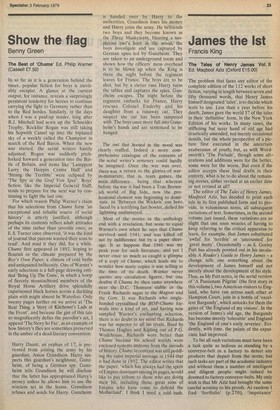Show the flag
Benny Green
The Best of 'Chums' Ed. Philip Warner (Cassell £7.50) In so far as it is a generation behind the times, popular fiction for boys is inevitably escapist. A glance at the current output, for instance, reveals a surprisingly persistent tendency for heroes to continue carrying the fight to Germany rather than to the Red hordes. Similarly, in the days when I was a paid-up reader, long after R.J. Mitchell had sewn up the Schneider Trophy, Rockfist Rogan was still taking his Sopwith Camel up into the biplaned sky of a weekly called the Champion in search of the Red Baron. When the new war started, the serial writers hastily adjusted; Rogan was suddenly pitchforked forward a generation into the Battle of Britain, and items like 'Lamppost Larry the Hairpin Centre Half' and 'Strang the Terrible' were eclipsed by The Spy in the Graf Von Spee'. Boys' fiction, like the Imperial General Staff, tends to prepare for the next war by continuing to fight the last one.
For which reason Philip Warner's claim that his selections from Chums form 'an exceptional and reliable source of social history' is utterly justified, although perhaps its contents reflect adult attitudes of the time rather than juvenile ones; as E.S. Turner once observed, 'it was the kind of journal that parents wanted their sons to read'. And read it they did, for a while. Chums first appeared in 1892, hoping to flourish in the climate prepared by the Boy's Own Paper, a climate of cold baths and antiquated bellicosity. One of Warner's early selections is a full-page drawing entitled 'Bring Up The Guns', in which a troop of fiercely moustachioed members of the Royal Horse Artillery drive splendidly caparisoned black horses across a darkling plain with might almost be Waterloo. Only twenty pages further on we arrive at The Real Thing, a Story of Kitchener's Lads at the Front', and because the gist of this tale so magnificently defies the parodist's art, I append 'The Story So Far', as an example of how history's flies are sometimes preserved in the amber of a dead literary convention: Harry Daunt, an orphan of 17, is prevented from joining the army by his guardian, Amos Grandison. Harry suspects this guardian's neighbour, Gunzheim, of being a German spy. Gunzheim tells Grandison he will disclose that the latter has appropriated Harry's money unless he allows him to use the wireless set in the house. Grandison refuses and sends for Harry. Gunzheim is handed over by Harry to the authorities. Grandison loses his money and Harry joins the army. He befriends two boys and they become known as the Three Musketeers. Hearing a suspicious owl's hoot in the wood, the boys investigate and are captured by German spies led by Gunzheim. They are taken to an underground room and shown how the officers' mess overhead is to be blown up when the King is there the night before the regiment leaves for France. The boys are to be shot, but by a clever ruse Harry turns the tables and captures the spies. Gunzheim escapes. The night before the regiment embarks for France, Harry. rescues Colonel Enderby and his daughter from a runaway car. They suspect the car has been tampered with. The boys once more fall into Gunzheim's hands and are sentenced to be hanged.
The owl that hooted in the wood was clearly stuffed. Indeed a more comprehensive catalogue of the contents of the serial writer's armoury could hardly be imagined. Once the war was over, there was a return to the glories of warin-miniature, that is, team games, the main difference being that whereas before the war it had been a Tom Brownish world of Big Side, now the professional element was beginning to dominate. In 'Between the Wickets our hero, faced by a terrifying fast bowler, defied his lightning undismayed.
Most of the stories in the anthology end with a revelation, but none to equal' Warner's own when he says that Chums survived until 1941, and was killed off not by indifference but by a paper shortage. It so happens that 1941 was my peak year for such literature, and yet I never once so much as caught a glimpse of a copy of Chums, which leads me to wonder how many copies it was selling at the time of its death. Warner never quotes any circulation figures, but one doubts if Chums by then came anywhere near the D.C. Thomson stable or the Frank Richards sagas in the Magnet and the Gem. It was Richards who singlehanded crystallised the BOP-Chums formula into a kind of art, and having now sampled Warner's enchanting selection, there is no doubt in my mind that Richards was far superior to all his rivals. Bred by Thomas Hughes and Kipling out of P.G. Wodehouse, Richards wore better than Chums because his school worlds were enclosed systems immune from the inroads of history. Chums in contrast was still peddling the same imperial message in 1944 that it had done in 1892. The editor writes that the paper, 'which has always had the spirit of Empire dominant among its pages, would like to pay tribute to those who are doing their bit, including those great sons of Empire who have come to defend the Motherland'. I think I need a cold, bath.


































 Previous page
Previous page